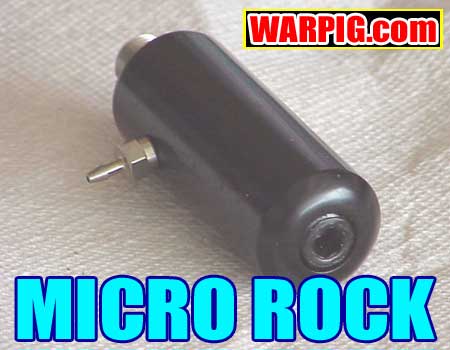  |
|
|
|
|
|
|
  |
|
|
|
|
|
|

What
do you think?
|

Palmer's Micro Rock by Bill Mills May 2002 While Glenn Palmer is well known for his custom airsmithing, he's probably even better known for the Rock regulator. The Rock was one of the first aftermarket accessories for the Worr Game's Product Autococker. Glenn took the stable and adjustable regulator he'd been building into his custom Typhoons and Hurricanes, and sold it as a replacement for WGP's stock non-adjustable pneumatics regulator.
The original Rock had to handle straight CO2 tank pressure being fed into it, so it not only needed to handle that level of fluctuation but it also needed a relief valve to let pressure out if the CO2 pressures spiked too high in the hot sun. Modern Autocockers are rarely set up on CO2, instead using double regulated compressed air as their standard power source. This meant that a lot of what was inside the Rock wasn't really needed anymore. By ditching the relief valve and further refining the reg deal and piston assembly, Palmer was able to build a new Rock that was both smaller and lighter.
Outside of the cap, the double 1/8" NPT connector that mounts the regulator to the paintgun also holds the regulator valve and seal in place along with the spring that pushes them against the piston disk.
Swapping out a Micro Rock for an older reg is a fairly straightforward procedure. The project begins with taking off the old regulator. First the pneumatics line from the reg to the 4 way needs to be removed. Then the hose barb needs to be unscrewed from the reg and the reg removed from the pneumatics block.
With the reg pin, it's seal and spring stacked into the NPT connector the Micro Rock body screws on, hand tight against the connector's o-ring. The regulator body should be twisted to an angle that will put the hose barb in a position that is well protected (i.e. not out to the side where a loop of hose will get ripped off on brush). The hose barb screws into place, also hand tight. It is important not to over tighten it with a wrench, to avoid stripping out the short section of threads in the regulator body.
On the field, the Micro Rock provides
the same solid performance Rock users are used to. There were no
real performance differences noted between the Micro Rock and the original
Rock that it replaced for testing. The real changes simply came in
a more compact front end.
|
| Copyright © 1992-2019
Corinthian Media Services. WARPIG's webmasters can be reached through our feedback form. All articles and images are copyrighted and may not be redistributed without the written permission of their original creators and Corinthian Media Services. The WARPIG paintball page is a collection of information and pointers to sources from around the internet and other locations. As such, Corinthian Media Services makes no claims to the trustworthiness or reliability of said information. The information contained in, and referenced by WARPIG, should not be used as a substitute for safety information from trained professionals in the paintball industry. |